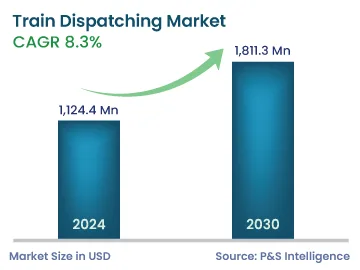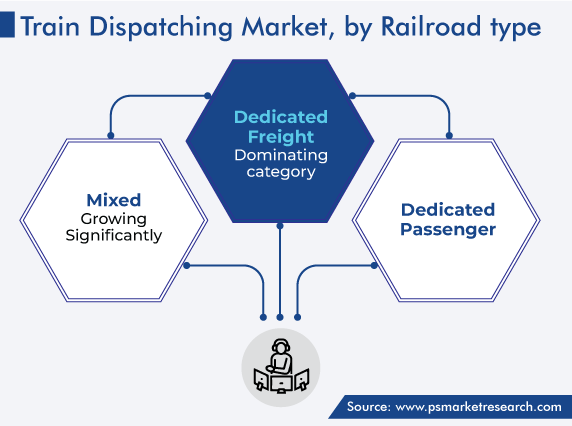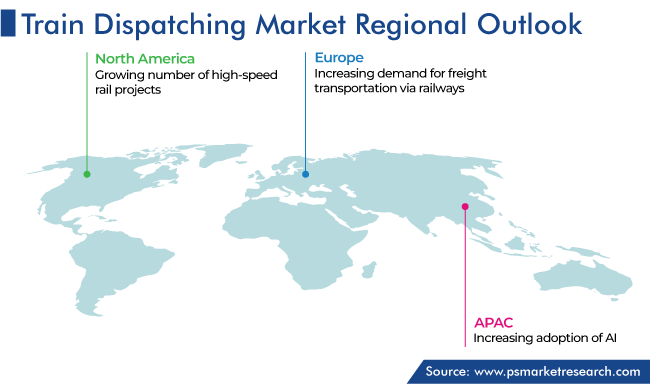Market Statistics
| Study Period | 2019 - 2030 |
| 2024 Market Size | 1,124.4 Million |
| 2030 Forecast | 1,811.3 Million |
| Growth Rate(CAGR) | 8.3% |
| Largest Region | North America |
| Fastest Growing Region | Asia-Pacific |
| Nature of the Market | Consolidated |
Report Code: 12817
Get a Comprehensive Overview of the Train Dispatching Market Report Prepared by P&S Intelligence, Segmented by Offering (Solutions, Services), Railroad Type (Dedicated Freight, Dedicated Passenger, Mixed), Deployment Model (On-Premises, Cloud-Based), Application (Dispatch Unit Management, Reporting and Analysis, Call Management), and Geographic Regions. This Report Provides Insights From 2019 to 2030.
| Study Period | 2019 - 2030 |
| 2024 Market Size | 1,124.4 Million |
| 2030 Forecast | 1,811.3 Million |
| Growth Rate(CAGR) | 8.3% |
| Largest Region | North America |
| Fastest Growing Region | Asia-Pacific |
| Nature of the Market | Consolidated |

Explore the market potential with our data-driven report
The estimated train dispatching market size stands at USD 1124.4 million in 2024, and it is expected to advance at a compound annual growth rate of 8.3% between 2024 and 2030, to reach USD 1,811.3 million by 2030.
The growth can be primarily ascribed to the advancing railroad technology and rising degree of urbanization. Moreover, the increasing requirement for smart cities is propelling this growth across the globe.
Train dispatching involves the management of railway lines and services, assisted by computers. Advanced, remote monitoring & control systems provide access to real-time data on the motion, position, and status of trains. This enables better coordination between railway operators, allows them react to accidents or delays, and optimizes timetables. All this ensures efficient railway network management and safety for both the trains and passengers.
Railway traffic is affected directly by globalization, while this mode of transportation is itself shaped by the increasing requirement for security, speed, and reliability. Thus, governments are trying to take it to the future to fulfill the demand for freight and passenger transportation with superior efficiency, irrespective of the number of steps required or distance to the destination.
There are several intelligent systems that provide information about the real-time position of trains, including centralized train control (CTC), positive train control (PTC), and advanced vehicle control. Primarily, they are used for monitoring the adherence to schedule and providing information to passengers regarding the location of the rolling stock before and during transit. This is done because the level of passengers’ satisfaction decides whether they continue to avail of the service in future or not, especially with airfares becoming increasingly competitive with train fares.
The requirement for better railroad infrastructure has been felt by all private and public operators around the world. Several countries in North America, Europe, and Asia-Pacific are, hence, strongly focusing on enhancing this infrastructure and making it smart with the help of a range of sensors and electronic circuits. For instance, According to the U.S. Department of Transportation, in 2022, the Federal Government announced a grant of over USD 368 million to improve rail infrastructure in the country.
The digitalization of railways propels the demand for train dispatching solutions. The digitalization helps in improving maintenance, operations, efficiency, and the passenger experience. Among the digital technologies used in the railroad sector are cloud computing, IoT, big data analytics, automation, and intelligent tracks, signals, and rolling stock. The growing focus on a digital railway, along with the advent of Industry 4.0, boosts the rate of digitalization, in turn, fueling the progress of the market.
Railway entities around the world have identified several primary areas for digitalization, such as passenger-friendly applications, collaboration with logistics partners, application integration for a cooperative railway platform, data analytics, freight consumer convenience, mobile apps, and alerts. For this, all aspects of train operations, such as signaling, passenger data systems, predictive maintenance, passenger car manufacturing, procurement, ground control systems, and ticketing, are being digitized and automated. For this, a real-time train information system developed with ISRO has been deployed by the Indian Railways for computerized chart preparation and passenger train data gathering.
Moreover, IoT is used in railways for connecting sensors, physical devices, and systems with the internet for the collection, sharing, and analysis of data on train movement and track condition. The large volume of data generated during operations also includes information about passengers, train schedules, and safety records, which enhances the process of decision-making. Similarly, digital platforms and mobile apps provide real-time information to passengers regarding delays, train schedules, ticketing options, and platform changes.
Based on railroad type, dedicated freight holds the major share, of around 45%, because of the need to offer efficient, cost-effective, eco-friendly, fast, and reliable delivery of goods. In addition, when run efficiently, trainsets consume less fuel and emit less emissions, thus improving the quality of the air and minimizing the carbon footprint. Currently, compared to road transport, railways emit one-fifth less greenhouse gases per ton transported and kilometer traveled.
They also possess a better operating power and volume, which drives the demand for freight transportation via railways. Further, almost 80% of the goods train kilometers in Europe are traveled on electric traction. Additionally, there is a 40-times lower risk of accidents on rail tracks than on highways. They are also considered more consistent with regard to timing and are less affected by the weather. Freight train dispatching systems majorly focus on optimizing operational efficiency, which further results in a higher success rate for shipments and makes the goods cost-effective for the end customer.
The mixed category is growing significantly too, as such lines can accommodate both freight and passenger traffic. Therefore, for managing different operations, they need more-sophisticated dispatching systems. For instance, all the seven trunk routes of the Indian Railways carry mixed traffic, which is why they are stretched beyond capacity. Hence, not only are they being decongested now but also being armed with cutting-edge sensors, relays, and other electronic systems for efficient and safe operations.

The services category is expected to witness the higher CAGR. In order to increase throughput on the existing rail infrastructure, freight and passenger train schedules must be optimized. The transformation of networks involves regular upgrades, maintenance, and operational monitoring. To help achieve all these objectives, implementation, support & maintenance, and training & education services are required by operators and maintenance agencies.
The solutions category is also growing significantly, attributed to the fact that solutions include a primary interface with visual modeling tools & real-time status, GIS interfaces & automatic vehicle location, mobile data terminal & mapping, and public awareness messages. These solutions help in providing the overall view of an incident, information regarding location, and various other details related to train operations to control centers.
Dispatch unit management is a significant application, as these units are responsible for controlling and coordinating the movement of trains, while maintaining high efficiency and safety across the railroad. Dispatch unit management also helps in monitoring the availability and status of emergency units, such as fire trucks, police vehicles, and ambulances.
Computer software for dispatching plays a key role in tracking the location and activity of every unit and makes sure that the most-suitable ones and those nearest to the incident location are dispatched. This type of dispatching enables efficient workload distribution, shift & schedule management, and resource planning for an on-time and well-organized response during an emergency.
Segments and categories covered in this report;
Based on Offering
Based on Railroad Type
Based on Deployment Model
Based on Application
Drive strategic growth with comprehensive market analysis
North America has the leading position in the market, and it will also hold the same position in the coming years, with a value of around USD 0.5 billion in 2030. This is attributed to the presence of key players and growing number of high-speed rail projects.
In North America, the U.S. holds the leading position, and it will grow at a CAGR of 8.5% during the forecast period. This can be attributed to the rapid adoption of advanced technologies, including machine learning, artificial intelligence, and the internet of things, to enhance efficiency, accuracy, reliability, and safety.

Moreover, the country is financially strong, with investments increasing in advanced railway technologies over the years. In addition, freight railroads contribute significantly to the economy of the country because of the rising import and export of oil and coal. Hence, to enhance freight transport efficiency further, newer rail lines are being laid across the country with all the necessary infrastructure to make them smart.
Among the advancements being introduced in regional train dispatching centers are multi-color displays and touchscreen monitors, for accurate and detailed information, computer icons, and enhanced user-friendliness. The provides information such as incident history reports, detailed maps, proximity incident reports, and database queries. The larger rail lines (both in terms of length and tonnage carried) are usually the first to be integrated with these advanced systems.
Countries and Regions covered in this report;
The 2030 revenue of the train dispatching industry will be USD 1,811.3 million.
The market for train dispatching solutions is driven by the strong focus on improving operational efficiency and line capacity.
Solutions are the larger offering category in the train dispatching industry.
Reporting & analysis applications are growing the fastest in the market for train dispatching solutions.
Digitization and cloud computing are trending in the train dispatching industry.
APAC is the fastest-growing market for train dispatching solutions, while North America is the biggest.
Want a report tailored exactly to your business need?
Request CustomizationLeading companies across industries trust us to deliver data-driven insights and innovative solutions for their most critical decisions. From data-driven strategies to actionable insights, we empower the decision-makers who shape industries and define the future. From Fortune 500 companies to innovative startups, we are proud to partner with organisations that drive progress in their industries.


Working with P&S Intelligence and their team was an absolute pleasure – their awareness of timelines and commitment to value greatly contributed to our project's success. Eagerly anticipating future collaborations.
McKinsey & Company
IndiaOur insights into the minutest levels of the markets, including the latest trends and competitive landscape, give you all the answers you need to take your business to new heights
We take a cautious approach to protecting your personal and confidential information. Trust is the strongest bond that connects us and our clients, and trust we build by complying with all international and domestic data protection and privacy laws
Customize the Report to Align with Your Business Objectives
Request the Free Sample Pages